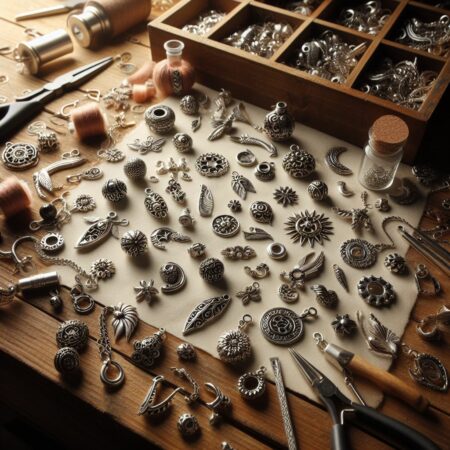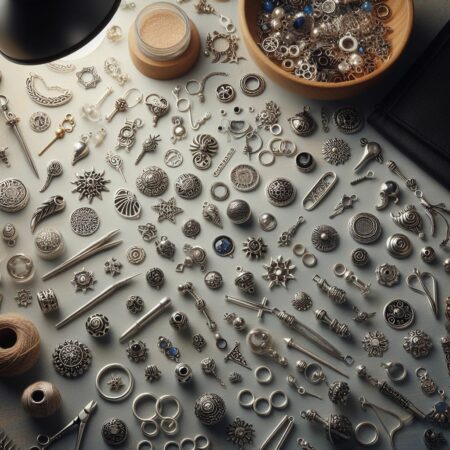Genuine copper beads and findings inspire an entire generation of jewelry designers and DIY crafters. In modern times, the current state of the metal is not surprising, as copper has been helpful to humanity for centuries. Much like gold-filled jewelry and sterling silver, genuine copper beads and findings remain relevant in the modern jewelry market this year, as there is a spending emphasis on less expensive metals for fashion jewelry and costume jewelry.
Jewelry with genuine copper beads and findings have long been considered the sweetheart of the jewelry world. Copper jewelry is something that you can gift on Valentine’s Day or during the holidays.
It is a perfect gift for any occasion, and there is always a solid fascination with metal. There has recently been a revival of copper bracelets for spiritual healing or energy healing. The traditional healing associations of the metal are periodically restored, improving the outlook of small jewelry businesses that carry copper jewelry in their inventories.
A quick look at Etsy will reveal the diversity of copper jewelry, and they’re all selling well alongside cheaper metals.
The pricing point is important here – the trend for two years now is that people are investing more regularly in budget-friendly metals. While expensive metals will always have a place in the fine jewelry market, small jewelry businesses would do well to focus on the fashion and costume jewelry markets, where sales volume is your friend.
Working with Genuine Copper Beads for the First Time
Are you new to crafting copper jewelry? Genuine copper beads are just as valuable as other types of semiprecious metals. Provided that you have a dependable jewelry-making supply, your copper jewelry will stand out in the market.
There are numerous advantages of learning jewelry-making skills. The first benefit is it’s very relaxing. Jewelry-making is mostly an enjoyable hobby that allows you to express your creativity.
Learning to make jewelry (especially super exceptional copper jewelry) is also a practical skill. Then, you can create stunning, handmade, and custom pieces for family, friends, and, possibly, potential customers.
Beginning jewelers may be unsure how to get started in the business or pleasure of jewelry making.
Even the most advanced jewelry makers struggle to create high-quality pieces using low-quality tools.
We recommend investing in the following:
– Jewelry-making adhesive such as E-6000
– Bead organizers
– Rulers
– Tape measures
– Crimping pliers
– Flat-nosed pliers
– Round-nosed pliers
– Wire cutters
Beaded jewelry is an art or craft that involves stringing beads together using a needle and thread or a thin wire.
Beads are small pieces of plastic, glass, gemstones, or wood with a hole in the center for threading. Copper jewelry has a higher value than jewelry made of lighter or more common materials. Therefore, genuine copper beads are an excellent choice for creating one-of-a-kind copper jewelry, such as copper bracelets and necklaces.
While you may initially be tempted to wring for tools that “sort of” fit the bill in your household toolbox, investing in the proper tools will help you produce higher-quality work—the cost of high-quality tools more than offsets the initial investment. In addition, while purchasing specialty tools may appear to be an investment at first, well-made and designed tools outlast their less expensive counterparts.
You may have been inspired to begin making jewelry by other jewelry artists’ intricate and creative pieces. However, as a novice, it is prudent to start small. There are numerous free online project tutorials geared toward those just getting started in the art of jewelry making.
By starting small, you can gradually expand your skillset and abilities until you can create the stunning pieces that piqued your interest in jewelry. Before making any purchases, it is prudent to conduct research and familiarize yourself with jewelry-making jargon.
Understanding the various functions of various materials will help you determine what you require for a project without overspending on unnecessary supplies.
Being conversant in the jewelry vernacular will also assist you in advertising your works if you intend to sell them. The vast array of jewelry-making styles can make even the prospect of beginning intimidating.
Should you begin your career with beaded work? Or is it the thought of incorporating leather into pieces that appeals to you more? Are you drawn to the simplicity of metalworked jewelry or the vibrancy of glass beads? Your style and preferences determine the answer. Which jewelry style do you find yourself wearing repeatedly?
An excellent place to start is by going through your jewelry box. Determine which pieces are your favorites and look for a common theme. For instance, if you enjoy the audacity of statement pieces that incorporate daring bead selections and avant-garde color, you will most likely struggle to replicate the minimalist style of metal stamping.
Why would you create jewelry that you would not want to wear? It is best to begin with, the style you enjoy the most and devote yourself to mastering the ins and outs of that style of jewelry-making before attempting something new. After getting one skill, you can always move on to another as your tastes evolve and apply what you’ve learned to master new abilities.
Anyone who has worked from home understands the frustration of not having their own space to conduct business. Working in an open area creates distractions and disorganization, and having your supplies scattered throughout the house rather than in one location results in lost time and supplies. Dedicate a room, a corner, or even just a desk to your craft. Organize your space with boxes, Tupperware, and labels. You can find creative storage ideas for any purpose online at sites like Pinterest.
Once you’ve established an organizational system and a crafting schedule, stick to it! Maintaining organization will ensure that your crafting hobby remains enjoyable and relaxing rather than becoming another unnecessary source of stress in your life.
Why Use Genuine Copper Beads or Copper in General?
Copper (including genuine copper beads) is a popular material for beginning metal jewelry artists for several reasons:
– It is an “authentic” metal that will not flake or peel.
– It’s soft enough to work with. Even copper wire has muted versions for beginners.
– Additionally, it is pretty affordable.
You’ll become concerned with soldering tools and other such items when you dive deep. For the time being, we’ll discuss what any jewelry artist or crafter will need to get started making copper jewelry – in addition to the standard jewelry-making tools.
When working with copper – or any precious metal – nylon jaw pliers are necessary. This is like standard pliers, except the jaws are completely covered in nylon. This prevents you from nicking the delicate metal and keeps your piece in excellent condition.
A wire end rounder – or file – is a file with a minor round groove at the end that houses the filing bits. It is used to remove burrs and round the end of your wire. Additionally, you can use a standard file.
The Ball Peen hammer or the Chasing Hammer is a unique jewelry-making tool explicitly used for hammering wire, bits, and bobs.
The steel bench block is essentially chunky steel that you use to hammer your item. Therefore, you need a solid block that will not yield (or will yield minimally) to your hammering for your metal to fail.
Place a leather sandbag beneath your bench block (if you want). It is slip-resistant due to the leather. However, it contributes to the dampening of the blow and the sound of your hammering.
Which Wires Are Best for Stringing Genuine Copper Beads and Other Elements?
You’ll primarily want round wire. This means that the wire is circular, making it the most versatile wire type. I occasionally use square wire to create a more robust and elegant base for something. Half-round is another popular shape. You’ll need round wire for these copper jewelry-making ideas.
Copper wire is available in three hardness grades: dead soft, half-hard, and complex. You’ll want dead soft for many projects simply because it’s the easiest to work with and conforms the most. On the other hand, you’ll want something sturdier like earwires that require the most stability. These are generally more difficult to hammer.
Gauge is a technical term that refers to the thickness of your wire. The gauge number indicates the wire’s thickness. 14-16 gauge provides an excellent, thick foundation. 20-22 gauge is thinner but retains its strength, making it ideal for findings. 24-28 is extremely thin, making it suitable for wrapping.
Copper Jewelry-Making Techniques (Important!)
Now we’ll discuss how to make copper jewelry. Of course, these are only the most fundamental copper jewelry-making techniques, but they are the necessary building blocks. And once you’ve mastered these, you’ll be able to create a great deal more like a DIY crafter.
Hammering
Hammering has two advantages: it hardens the wire and imparts texture. Hammer when you’re satisfied with the shape (more or less), as it does help to solidify it. Attempting to reshape a hammered wire frequently results in its breakage.
To hammer, position the metal on the bench block (which can be sitting on a leather sandbag if you want). To flatten, use the flat side of a hammer. Hammer with the ball side to add texture.
Bear in mind that as you hammer, your metal will respond appropriately. You’ll notice that it bends and curls with the impact and direction of the hammering. As you progress with the task, ensure that you readjust and guide your metal in the direction you desire. When the wire curls upward, flip it over. Rotate your piece if it moves away from you and you want it to move toward you.
Wire Wrapping
Wire wrapping is a distinct skill in and of itself, and it can be extremely simple or highly elaborate.
If you guessed straightforwardly, you were correct. You can accomplish a great deal with some freeform wrapping without succumbing to the pressure of crazy designs.
Wrapping is essentially about manipulating the wire to do what you want and securing genuine copper beads, and it’s a delightful beginner skill. I’ve included a couple of projects below to get you started. Generally, when wrapping, ensure that your initial coils are flush with the primary wire you’re wrapping. This is accomplished by squeezing it tightly with flat nose pliers.
Rounding the Ends of Wires
Rounding your ends is critical for finishing a wire piece when making copper jewelry, especially those with genuine copper beads. This is particularly critical for loose ends – those not flush with another wire. Rounding refers to filing away the burrs that remain after cutting a piece of wire. This can be accomplished by gently removing those bits with a file or end rounder.






